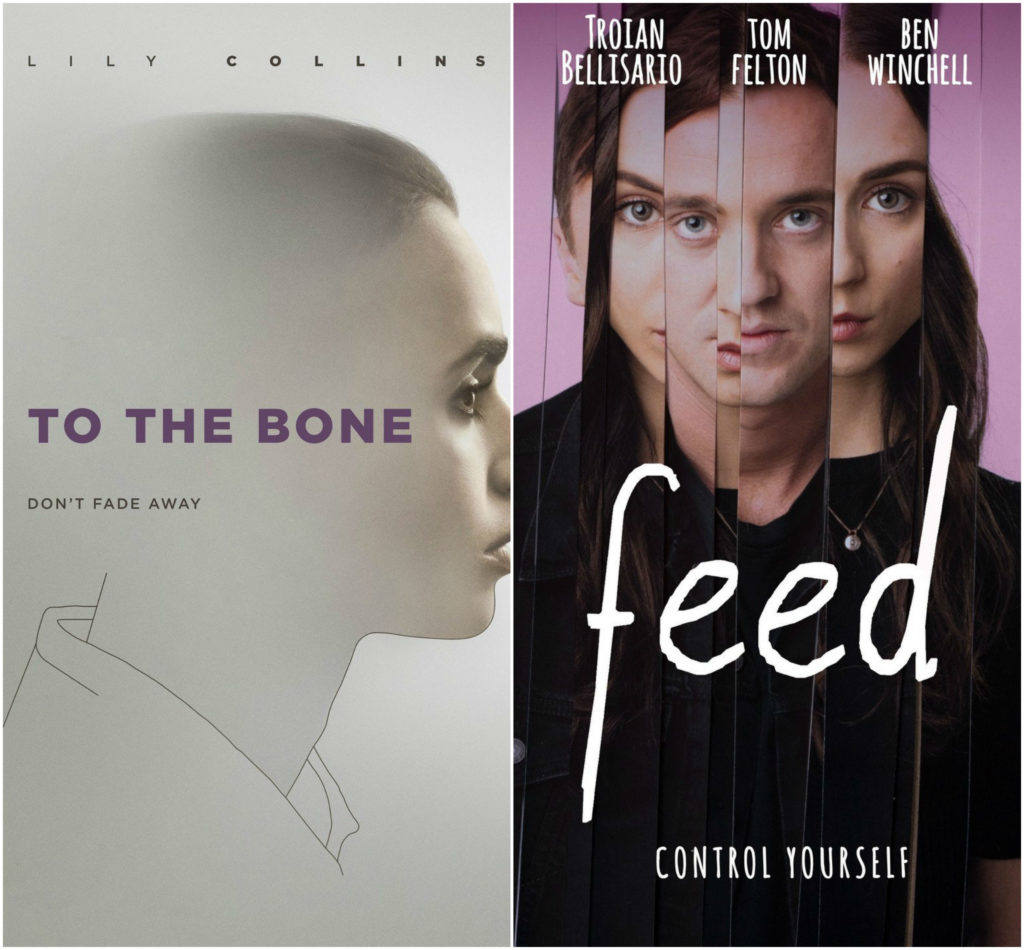Warning of what lies ahead: spoilers for To the Bone and Feed. More importantly *Trigger warnings* for eating disorders and anorexia.

Netflix’s To the Bone, directed by Marti Noxon and starring Lily Collins, has probably popped up all over your social media streams lately. It’s the story of Eli’s (Collins) struggle with body image and anorexia. An artist and college dropout, she’s gotten herself kicked of a few rehab programs. Her family is determined to get her healthy, which leads Eli to a non-traditional doctor and group home filled with other youth with eating disorders. At first we see Eli thriving, but as we find out a secret only Eli (and her family) know the full story about, we being to fear for her life.
If you’ve heard of To the Bone, you’ve probably heard of Feed, written by and starring Troian Bellisario. Olivia (Bellisario) is in line to be valedictorian at her high school when a car accident takes the life of her twin brother, Matt. It’s not until Olivia starts seeing Matt in her dreams, then in real live that you understand the level of grief she is feeling. Through the ups and downs of the next several months, she has Matt back except he get progressively more aggressive. The psychological thriller has you wondering what’s going on until you realize the twin she’s been seeing actually represents her anorexia, not her brother.
Both films have gotten praise and criticism. From romanticizing and over triggering, to not going far enough to break stereotypes surrounding the portrayal of anorexia in the media— it seems there is no perfect way to tell these difficult stories.
But before we get to that, let’s throw it back with a little #FlashBackFriday.
Every sitcom I’ve ever watched has tried and failed to have a discussion surrounding eating disorders. Full House, Lizzie McGuire, Degrassi (a moment of silence to remember the time before Drake was Drake), Pretty Little Liars, and so many more have given it a go. It looks something like this: in a single episode, a young, white, female character develops, struggles through, and recovers from an eating disorder with zero relapses and little explanation of underlying mental health issues.
To the Bone and Feed don’t break the white female story line. But they both do what hasn’t been done before and give a close-up look at the issue of eating disorders. Unfortunately, neither fully captures the experience of someone struggling between what their mind is telling them and how their body reacts.
As you watch Eli in To the Bone do so many crunches that she bruises her spine, or Olivia in Feed run almost 5 miles seemingly multiple times a day, you might think, “what’s wrong with being fit?” or “wow, she’s dedicated!” That’s not really what you want from an audience who already doesn’t get the difference between healthy body image and distorted and self-destructive body image.
So is there anything good to be taken from the imperfection of these TV shows and movies?
Follow me on this.
While To the Bone is a story to recovery and Feed is a story of (almost?) recovery, they do open a deeper discussion than poor DJ Tanner when she stopped eating and over-exercised because she was extremely nervous for a winter swimming party. You see, we never discussed eating disorders again with DJ Tanner, Lizzie McGuire, Emma Nelson, or Hannah Marin. As their stories went on, we probably forgot they even struggled in the first place.
To the Bone and Feed both show you the severity of eating disorders. They show how having an eating disorder affects your whole life, your family’s lives, and your friend’s lives. They tell you that there isn’t that one magic reason an eating disorder starts and there are layers to recovery, including relapse. They tell you that help will include a treatment team, not solely your friends and family. They tell you the harsh voice in your head is wrong. They tell you, while the journey may take a long time, there is hope.
Because eating disorders have the highest mortality rate of any mental illness, calling attention to how they are portrayed in the media is important. In fact, portraying them in the media at all—however imperfectly—is a step in the right direction. It’s about making sure that stories like To the Bone and Feed are out in the world sparking all the discussions they have been recently.
Is there room to grow? Absolutely. And getting the discussion going is just the start.
My advice for the TV show and movie makers of the world (because I’m sure they will ask one day):
Diversify, diversify, diversify!! These issues leave no zip code, no racial identify, no economic class untouchedAdvertise how to get help at the beginning and end of each programInclude trigger warnings
As long as the goal remains to more perfectly portray real-life people with real-life challenges, creating empathy, while letting them know help is available, we can settle for progress not perfection.
National Resources
Crisis Call Center 800-273-8255 or text ANSWER to 839863 Twenty-four hours a day, seven days a weekcrisiscallcenter.org/crisis-services
National Association of Anorexia Nervosa and Eating Disorders 630-577-1330 10 a.m. to 6 p.m. EST, Monday to Fridayanad.org National Eating Disorders Association 800-931-2237 9 a.m. to 5 p.m. EST, Monday to Friday nationaleatingdisorders.org
Thursday’s Child National Youth Advocacy Hotline 800-USA-KIDS (800-872-5437) Twenty-four hours a day, seven days a weekthursdayschild.org

